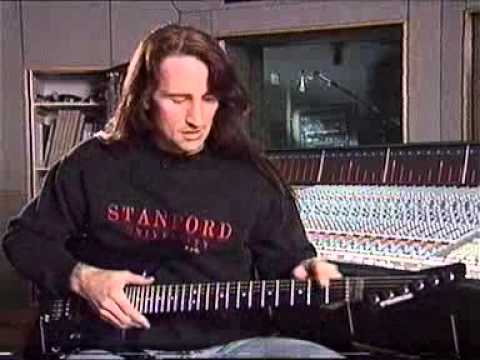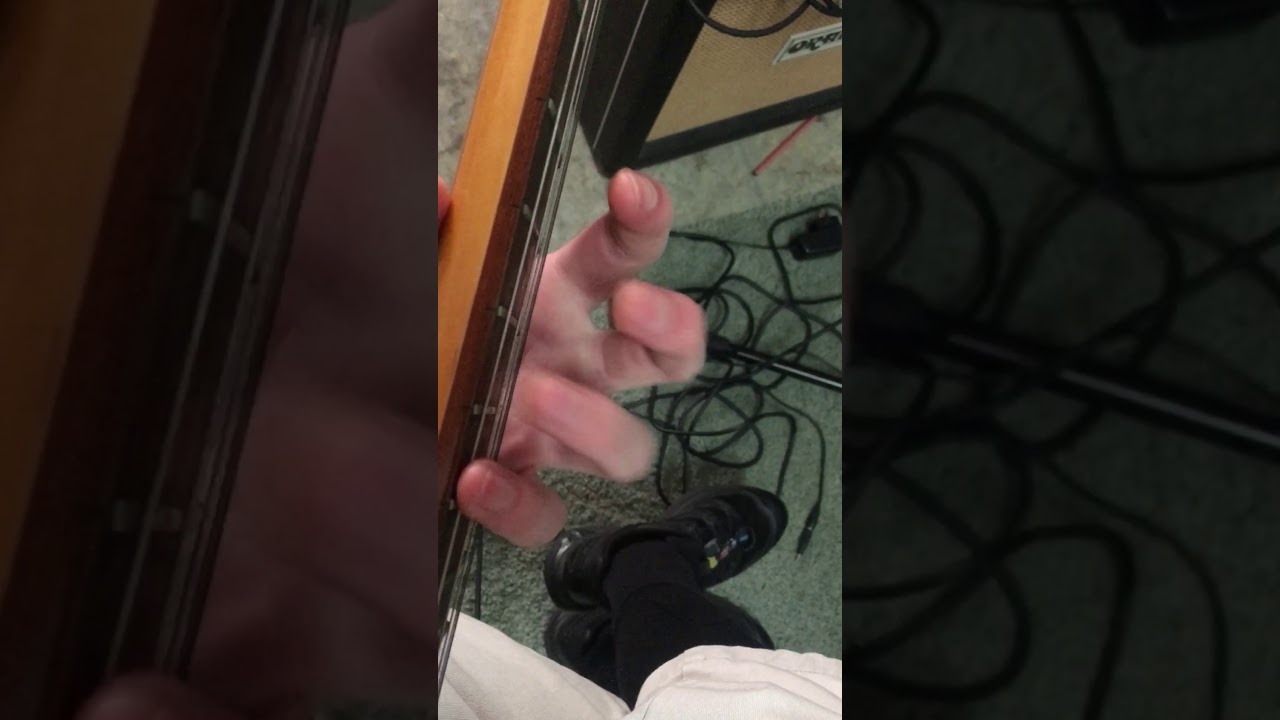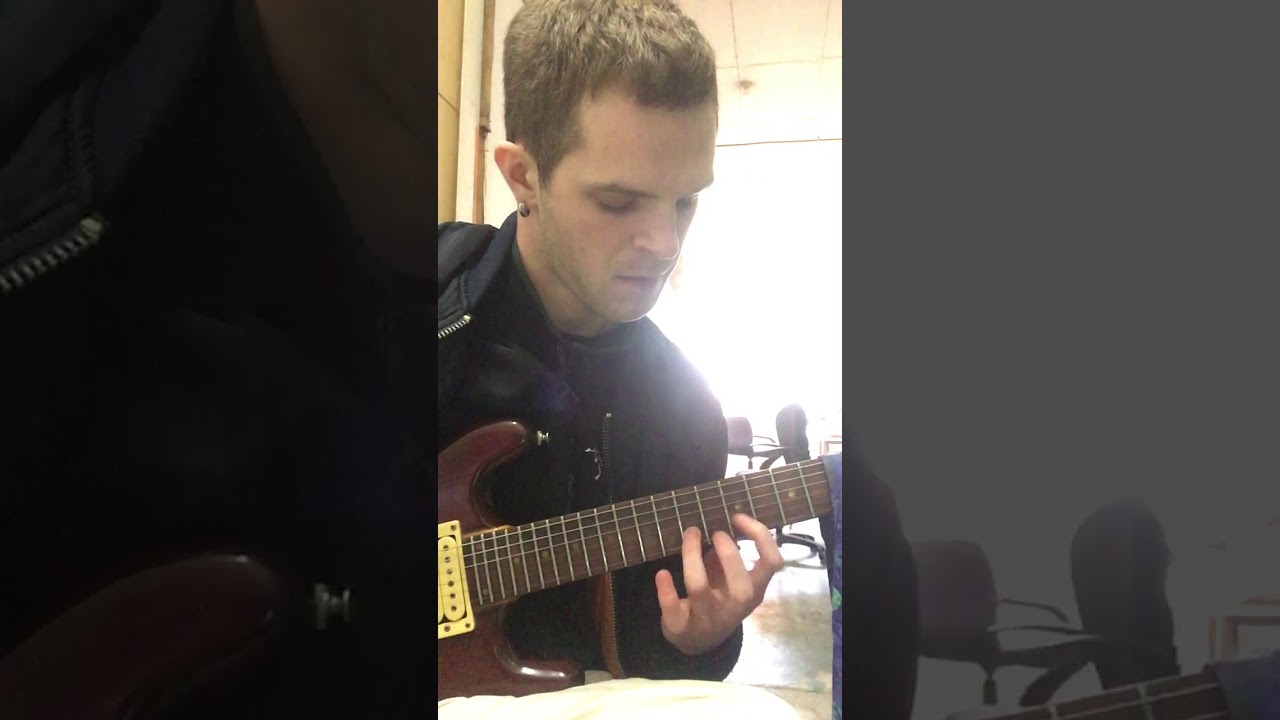Is there any chance someone could make a video demonstrating these up close and not at blazing speeds? Like a slow speed and medium speed? I’d love to see a breakdown of how these are executed and how people who are first trying them out should sound like or at least how they know they’ve done it properly.
You mean Marshall Harrison doesn’t clear things up for you? 
Maybe this one is a little more approachable:
I have problems with recording videos right now, but I can record video unplugged using my phone if it would be helpful…
Basically you lift your finger at the same time (or a bit earlier) when you hammer with your next finger.You may practice it by starting with your finger ressing the fret then you lift it while making hammer on with another finger. Another great exercise is staccato hammer ons.
P.S. Obviously using high gain makes it much easier
The Marshall Harrison one, not really. I watched that. I understand what descending hammer ons are supposed to sound like ultimately. But when youre practicing it at slower speeds and tempos, and not getting it, it gets hard to know what to correct and what to aim for. It would be great to see someone demonstrate them at a slower pace. The 2nd video is definitely more what Im talking about so great find. Would love to see more!
Apologies for my ignorance, but what else is there to see? Fast or slow they should sound the same right?
Not trying to start arguments or anything…this topic of descending hammers it new to me. I am classically trained and I can promise you, on the classical guitar, this is impossible to do in a way that would result in even tone, that would be audible in an un-mic’d performance. I know this isn’t a classical guitar forum though and I may be comparing apples to oranges. On electric, sure, this is totally possible. I can’t see why anyone would want to spend the time it would take to master this though. Let me explain.
That video that @LuckyMojo posted of Marshall Harrison explaining this is great, but it’s almost self contradictory. Around 6:40 he talks about when hammering ascending, leaving each finger down until the next finger hammers so that there is no silence between notes. This is indeed the definition of legato. How could we possibly do the equivalent by descending, on one string, and using all hammers? There would have to be a small gap of silence, so this wouldn’t really be legato. Sure, if you did it fast enough maybe no one would hear it as silence.
Secondly, around 3:30 he demonstrates what I consider as close to a properly executed pulloff (i.e. from a classical technique perspective) that I’ve seen a rock guitarist do. He is of course exaggerating the movement and bending the strings a little. I agree that this changes the tone…but in the way it should. It’s creating a miniature rest stroke and that should give the pulloff the same roundness in tone we get hammering. It should not be a different tone. We’ve come to accept the way pull offs sound when we ‘lift’ off since that is how most rock guitarists perform pulloffs, so anything other than that is going to sound ‘different’. If you lift off rather than pull (down), the second note is quieter and thinner in tone than the note before it (unless you’re on your second slur, done the exact same way of course lol) To my ear, a properly executed pull off should have the same exact tone and volume as a properly executed hammer on. Pulling ‘down’ should give you this.
So maybe instead of striving to do descending hammer ons, an alternate approach is to strive to do descending pulloffs with proper classical technique. If we do this, we’ll get evenness of tone and volume and complete connection between notes in legato. It seems easier to me than figuring out descending hammers. I guess that could differ between individuals, and I’m sure many would disagree with me in general about this approach. That’s cool 
The all-hammers technique originates with Holdsworth, and guys like Bret Garsed and Harrison have taken the ball and run with it.
I can’t say I use it much, I prefer the articulation you get from pulloffs - but that’s exactly what they’re trying to avoid by using all-hammers. Holdsworth described it as trying to emulate the sluring technique of horn players without tongue articulation.
Right, the no-tongue articulation ideal I am familiar with. I feel like it’s wanting the guitar to do something it was never designed to. Horn or wind instruments would have a steady stream of air to maintain volume and tone. We’ll never get that on guitar without extreme processing or an e-bow haha. Bending over backwards trying to approximate this just seems like a waste of time to me. Maybe I am just refusing to accept what the legato guys are going for. To my ears, using classical technique on hammers and pulls makes every note sound identical.
Basically with a high-gain amp what most people call ‘all hammer-ons’ is actually a ‘wrong pulloffs’ ) I mean you just lift your finger fast, that’s all.
As for calssical guitar… I actually developed my hammer-ons on an acoustic (I was self taught so I didn’t know that such thing as ‘pullofs’ were existing  )
)
Here’s an example of different techniques:
first - traditional hammer-ons + pull-offs
second - staccato hammer-ons
third - all hammer-ons, which sounds not as sharp as staccato
fourth - all hammer-ons with distortion
Cool thanks, So basically for descending hammer ons, after you lift the first hammered-on finger, the string has to come up a bit before you place the next descending hammer on down?
I guess because it’s just another good tool to have in one’s pocket.
Yep. Basically slow staccato hammer-ons sound more powerfull because string comes up more than when you play fast hammer-ons only (in my example you could even hear open string ringing between staccato hammer-ons).
Another problem with fast runs is that sometimes it’s not enough time for fingers to make that ‘scissors’ movement. So the string played is whether not too high or - in worst case - it’s still muted by another finger. It usually happens with fingers that are less independent (middle-ring, ring-pinky etc) while index-middle combination usually works well even an acoustic guitar.
I’m not much a fan of hammers only since I learned how to do pullofs (more or less  ). But I sometimes use it unconsiously when surfing the internet with my guitar in my hands - I just start to play some random melodies using hammer-ons without thinking (since my right hand is busy with a mouse) ))
). But I sometimes use it unconsiously when surfing the internet with my guitar in my hands - I just start to play some random melodies using hammer-ons without thinking (since my right hand is busy with a mouse) ))
— update —
Theret’s one additional thing to say about hammer-ons. It’s more about speed than force. The faster the string strikes against the fret - the better hammer-on you have. Some people try to use more strength which leads to unnecessary tension.
Basically I agree. Since I play with distortion I don’t distinguish classical legato vs hammers-only, I jsut let my left hand to do what it wants to. But as for ‘waste of time’…
Some guy wanted to play arpeggios like those piano guys and he ended up inventing sweeping, another guy wanted to play scales and created TWPS ) Moreover, for me playing is not about sound only, I like the vey feeling of playing. And sometimes hammers-only approach gives that interesting sensation. Experimentations with a guitar is a funny thing actually )
Total agreement there. I probably shouldn’t have used the phrase ‘waste of time’…in a way, nothing really is as long as it’s enjoyable. Sometimes just doing a technique for the heck of it is fun.
What I’m postulating is that the intent of this descending hammer concept is answered by doing slurs the way good classical guitarists do them. That should yield the result of a completely uniform legato sound, where there is no difference in tone, volume or attack of any note, regardless of the direction of the line.
I really don’t see how anyone can argue with players of the caliber of Holdsworth and Harrison having a clearly defined tonal discrimination between these techniques. I don’t believe they would make the effort to develop the technique if it didn’t create a perceptible change in tone quality to their ears.
Whether the law of diminishing returns in gaining facility in the technique is worth your time is probably a different matter 
I think pull-offs work just fine for most players, even very notable legato players like Tom Quayle, Tim Miller, Satriani, etc. use them. It’s always interesting to know that another way is possible.
Arguments about the effectiveness of the technique or not withstanding, the power of backwards hammer ons is not just the the change in articulation, but really the change in the types of lines you can achieve with it. The technique really clicked for me when I started thinking of it as ‘one handed tapping’ rather than a type of slurring, and as such there is a subtle hand position change that occurs when you do it - the fingers are more ‘straight on’ to the string, and you actually need quite a bit more height to achieve each hammer (I try to think of keyboard playing technique when I do it).
Top down view of chromatic 1234 - hard, significantly easier with pulloffs
front on example of scalar playing (easier, descending 4s part much easier with backwards hammers than pulloffs)
I’m not using the picking hand in these videos to mute, which is why the first example has string noise and the second example I’m using a piece of cloth as a string wrap
Nice man! cool stuff!
I’ve been thinking about this comment. I know forum opinions can get heated when people feel strongly, so please don’t take any of this as me being upset or being aggressively arguing. I have a lot of respect for your opinions. You’re one of the most accomplished transcribers I’ve crossed paths with and you clearly know your stuff. Also, I state all this with humility. I’d never dream of questioning the abilities or contributions of players like Holdsworth or Harrison. That said, I don’t know that amazing technique necessarily equates to tonal awareness. Those are 2 different skills. There are audio engineers who can pinpoint specific frequencies and hear tone on a level most humans don’t…but they can’t play a simple pentatonic scale 
My perspective on this topic of descending hammers as a whole is that classical guitarists are much more tone conscious than guitarists in other genres, in general. I know everyone talks about tone all the time, but when all you have to create the tone is your fingers, no amp, no mic, it is a different ballgame. I was a rock guitarist for several years before seriously studying classical guitar. And by studying, I mean getting lessons from awarded conservatory trained classical guitarists and majoring in music with a concentration on classical guitar performance. I didn’t just casually take lessons from some guy at a local music store. I was immersed in it for years.
When I began, I couldn’t believe how much emphasis the purists placed on tone production. Before even playing pieces or even traditional exercises, I had to learn how to create a full and consistent tone. This required carefully shaped fingernails of just the right length, which then had to be 3-step buffed. The nails must be as smooth as glass so there isn’t even the hint of scratchiness in the sound. If just the right combination of fingertip flesh and fingernail aren’t used when plucking the string (at just the right angle), the results just aren’t good. I mention all this because I had no idea this was involved. I thought playing classical guitar just meant playing classical pieces on a guitar with nylon strings, fingerstyle. What it takes to produce the sounds we hear from a master like John Williams, Christopher Parkening or David Russell is almost taken for granted because they make it look so effortless. I just don’t think any other genre of guitar puts that type of detail into their tone production. They don’t need to either, because they are aided by a pick, or an amp, or steel strings.
So with that as a backdrop, when it comes to tone production, I am almost always going to side with what the classical guitar community preaches. If classical guitarists, with centuries of tradition that has been gradually refined, say “though shalt play descending slurs like so”, I’m going to listen. If some amazing electric guitarists, like Holdsworth or Harrison has an alternate perspective I definitely consider it as viable. But when I play an electric guitar with, or without distortion, and I use classical technique on the slurs (which I have to date seen no rock guitarist do), I hear no difference in tone whether ascending or descending. To me, that accomplishes what they were trying to do, just with a different technique. It satisfies what Marshall Harrison said about each note ringing until the next note is played. Descending hammers, by definition, do not satisfy this criteria.
My last point about “arguing” with players of an elite caliber:
I absolutely think we should question everything elite players say, and do. This site itself exists because Troy questioned things. What the elite were saying they did, and what they were actually doing, were not the same thing. In one of Troy’s videos he detailed a conversation he had with MAB on a forum years ago, where Troy made a flash animation of his theory on escaped picking. MAB’s response? This isn’t a direct quote, but it was to the effect of “Nice animation. I don’t think anyone really picks that way though”. Astonishing! And this is coming from someone with almost unparalleled picking technique, who definitely has an escape in his picking! Additionally, how many elite players have declined to even be interviewed by Troy because they don’t think there’s anything magical about their right hand technique and that everyone should just find their own path? At least John McLaughlin and Guthrie Govan have responded with a similar graceful declination. The point is, these guys are awesome, but we shouldn’t hang on their every word. They aren’t correct about everything.
This is my main point. I don’t think, to my knowledge, any rock players approach legato as the classical guys do. This is “another way possible” that I don’t think has been explored in the electric guitar realm. I think if it were given a fair shot, it would be seen as a superior way of accomplishing, from a pure tone projection standpoint, the endeavors of descending hammers. I’m pushing this so hard because I think it’s something most people don’t know about. It should get some daylight. I think it’s also easier to master than descending hammers. So anyone putting in tons of effort in learning descending hammers just might get everything they’re after if they’d slur like they went to Julliard 
So @LuckyMojo, I hope nothing I put in here is taken offensively. If we were in the same room talking about this over a beer, I’d have a smile on my face while stating all my points. Really just trying to bounce some ideas around on the community. I think in general there is a lack of awareness of classical guitar technique among rock guitarists. I’ve lived extensively in both worlds and I’m just trying to share some perspective. Thanks again for all the awesome videos you posted on this thread! And though unrelated, thanks for all the amazing transcriptions you’ve posted on this forum! You’re doing a great service.





